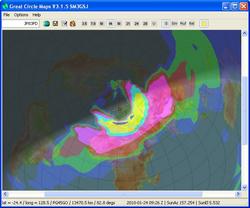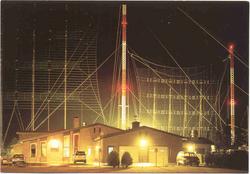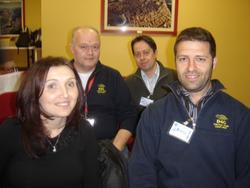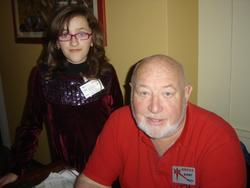 March 17, 2010 Editor: Ward Silver, NØAX | ||||||
IN THIS ISSUE
NEW HF OPERATORS - THINGS TO DO You just can't not have fun in a contest where the multipliers are prefixes! After two solid weekends of great DXing in the ARRL International DX contest (I hope you stuck a toe in the water and gave it a try!) it's now time for the CQ WPX SSB everybody-works-everybody free-for-all. Do you have a new KB1 or KF7 or KJ4 or KF5 call sign? Tag - you're it! Have fun and get in some great operating practice. BULLETINS There are no bulletins in this issue. BUSTED QSOS Caffeine levels must have been low in the Contest Update Editorial brewmaster last time - numerous grammatical solecisms were in evidence. I've changed to French Roast in response to the evident langour. CONTEST SUMMARY Complete information for all contests follows the Conversation section March 20-21
March 27-28
NEWS, PRESS RELEASES, AND GENERAL INTEREST The new ARRL Rookie Roundup contest is attracting the attention of clubs and new hams. While the new ARRL Web site is being completed, the Contest Branch Manager's usual ability to post information and answer questions is unavailable, unfortunately. In the meantime, Sean KX9X has created an off-site contest blog just for the Rookie Roundup. He will be adding material regularly to help get a newcomer started or to answer questions about the contest. It is quite possible that there will be modifications to the published procedures as we come up to speed, so please watch the blog for important updates about the contest.
Here's an opportunity to become an expert on the upcoming CQ WPX Contest. The Potomac Valley Radio Club's webinar, "Inside the CQ WPX Contest" with the contest's Director, Randy Thompson K5ZD. Randy covers topics including rule changes, log checking, results reporting, participant surveys, and winning strategies for the contest. This is your chance to get a peek behind the log submission robot before 0000Z rolls around on March 27th! The Webinar is available from the "Recorded Webinars" link. (Thanks, Ken K4ZW) North Coast Contesters are pleased to announce that Joel Harrison, W5ZN will be the main speaker at the 2010 Dayton Contest Dinner. An active contest operator, Joel just finished a four year term as President of the ARRL in January of this year. (Thanks, Tim K3LR) Art KZ5D writes in with news of the new monthly Mini-CWT Tests sponsored by CWops. Each event is an hour long and held on the second Wednesday of each month. Only 3 bands are to be used - 20, 40, and 80 -- from 18 to 28 kHz above band edges. There are three separate events organized by location, so check the Web site for complete details and how to report your score. The next event takes place on 14-15 April. Oh dear - and just when you thought contesting was a safe activity! Doug K1DG relays a Snopes.com article about malware activated by prompting Internet Explorer users to press the F1 key. As if it wasn't hard enough to find a clear CQ-ing frequency!
From issue ANS-073 of the AMSAT News Service Weekly Bulletins we learn of Roger SM3GSJ's terrific great-circle map program, GcmWin. Recent enhancements make it very useful for the VHF+ contester chasing grid squares. The program supports overlays for confirmed and worked grids and some interesting propagation features for the HF contester. (Thanks also, John K8YSE) Killer electrons? Not an unwanted arc in the shack, but high-energy electrons posing a hazard to astronauts and satellites during magnetic storms! This IEEE Spectrum story describes the processes by which killer electrons are accelerated to lethal levels using ultra-low frequency (ULF) waves in the Earth's magnetosphere. George VE3ERP reports that he has just released HAMCALC version 118. This popular package of simple calculators now includes a Filter Tutor, a Filter Impedance Matching utility, a calculator on the Cark Y Airfoil, and upgrades the Stripline-Bandpass Filter, Humidex, and Wind Chill calculators. Time to go comb the antenna? This story from Science Daily describes the development of water-repellent coatings that consist of tiny hairs, similar to those found on spiders. The coating works on both hot and cold water, reportedly. Not only does the ultra-repellent surface shed water, but the water carries away dirt, too - a self-cleaning antenna element at last! Web Site of the Week - Twenty-five years ago, domain names began to be registered for the Internet. Who were these pioneers? How many are still around? You can find out on the 100 Oldest Internet Domain Names Web page. Scan the list and you'll see some old friends. You won't be able to resist the urge to see who's still active! WORD TO THE WISE 3830 - The popular score-posting Web service created by Bruce WA7BNM and from which Dink N7WA creates score summaries after each contest. Dink writes, "Yes, you can (and should) go back to the 3830 Score Submission page and resubmit your score with corrections. You only need to re-enter the items shown in RED. When you click on Submit, you'll be given a choice of reposting or just updating the summary database. Then, when you are done, shoot me a quick email (contest, call, and what needs fixing). Why? The correction you submitted requires manual review before incorporation (you can thank a few pranksters for that)." The name 3830 refers to the frequency of 3830 kHz on which contesters used to meet after the contest to exchange scores. SIGHTS AND SOUNDS The PJ2T log summary, hour by hour breakdown, team photo, and photo album for ARRL DX CW at PJ2T are posted online. Big 10 meter openings were reported for the first time in quite a while and the team "may have had more fun than the law allows", so the operation was a big success! (Thanks, Geoff WØCG/PJ2DX)
Who says Short-Wave Listening is going the way of the Branly Coherer? Bertrand F5PL used his 3.5-meter dish near Castelnaudary, France to listen to the signal from Mars Express during the recent Phobos Flyby. It might not be that much longer before the Elther-Mathes Cup is within the amateur's grasp! (Thanks, Brent W5WW and others) Popular Science magazine has placed its entire 137-year history online with the cooperation and assistance of Google. All of those fantastic articles about future technology are now just a click away! Remember the flying car? It's in there! Occasionally, the question arises of whether anyone has ever operated from all 40 CQ zones. The answer is, yes, N6AA and N6ZZ have accomplished that feat and others are hot on their trail. Here's a great PDF slide show about Phil's excellent adventures. You'll be surprised at what his last zone turned out to be! RESULTS AND RECORDS Randy, K5ZD, doesn't have enough to do with his fine management of the CQ WPX CW/SSB contests, so he teamed up with Don, AA5AU, to bring up a searchable database of the entire history of CQ WPX RTTY contests. The entire 15-year history of the CQ WPX RTTY contest is included in the database. (Thanks, CQ RTTY Contest Director, Ed WØYK)
The results for the 2009 Ohio QSO Party have been posted at the OhQP Web site. A printer friendly version of the results and some additional statistical breakdowns will be available soon. (Thanks, Mad River Radio Club President, Jim K8MR) Krasimir LZ1GL reports, "We are glad to announce that the results of the LZ Open Contest 2010 are ready and published. Thanks to everyone who has participated!" Preliminary results for the 2009 New York QSO Party are available. Paul K2DB reports, "We are still compiling results on plaque winners and will be putting those up shortly." From the 12 March edition of Amateur Radio Newsline comes news of some REALLY fast code copiers. LZ4UU, DJ1YFK and EW8VK achieved an amazing 1231 characters per minute. That's about 200 wpm! Gee, at that speed, I can't even tell it's code! OPERATING TIP Listening to yourself operate can be an educational, if occasionally painful, experience and a great way to improve technique. It's relatively straightforward to capture the audio as a WAV file with the software that comes with your sound card. Converting to MP3's for your audio player lets you listen anywhere, anytime. Programs that convert WAV to MP3 format include Audacity (also records the audio and requires the LAME plug-in as described on the Web site), LameDropXPD, and BladeEnc. (Thanks, Zack W9SZ, Ryan N2RJ, and Doug W9WI) TECHNICAL TOPICS AND INFORMATION VHF+ contester, Les N1LF reports, "I've been following the articles in DUBUS magazine with great interest concerning the Loop Fed Array Yagi designs of GØKSC. Chief among the advantages cited is lower overall noise response, and wide bandwidth." At low signal-to-noise ratios, a pattern with lower sidelobes can have a dramatic effect, particularly to urban and suburban environments. The antennas are being produced commercially in the US by Force 12. L-Com has just introduced a series of AC/DC Lightning Protectors for low-voltage control lines, just right for rotator and switch cables. Units are available for 12-, 24-, and 48-V lines. The protectors have removable screw terminal strips for fast and easy setup, and a ground clamp provided on the outside of the enclosure for easy grounding. Each Lightning Protector is able to protect up to 8 individual single-ended control lines. (Thanks, Eric K3NA)
From the March issue of the Mount Airy VHF Radio Club "Cheesebits" newsletter comes the report of an article by IK1HGE on a computer-modeled quagi with improved performance over N6NB's original antenna design. (Thanks, Lenny W2BVH) During this spring's antenna work, you'll want to be sure to use the right drill size for tapping threads. You can find a printable chart of drill sizes on the Wikipedia or you can use Google by searching for "tap drill size" (Thanks, Dan N3OX and Bill W4BSG) As long as you're up there on the tower, Gerald K5GW observes, "One of the major failure modes with type-N connectors is having the shield work loose due to pulling and twisting the cable. A short piece of heat shrink tubing over the clamping end of the connector and a couple inches of the coax will provide excellent reinforcement and improved reliability." Here's a great article from the ARRL's Technical Information Service showing you how to wind high-quality single-layer, air-core inductors. You'll find it handy as you construct antenna matching networks or high-power filters. While we're on the subject of winding inductors, if you're using a toroid with a rectangular cross section, stacking cores increases inductance proportionally to core height: stacking two cores doubles the inductance of a single core, three cores triples it, and so forth. (Thanks, John KU4AF) At a recent hamfest, I was handed a card describing the TiltPlate by NN4ZZ. This handy device replaces an antenna's boom-to-mast plate and allows the antenna to be swiveled, bringing the entire antenna to ground level on a tilt-over tower for easy access. The article "Fighting Cable Chaos" on page 117 of the April Popular Mechanics has lots of ideas for our so-called "wireless" stations. I liked finding out that garden supply stores stock inexpensive foam-covered wire that can be used as a reusable wire tie made for the outdoor environment. Your Beverage went dead? Guy K2AV provides this troubleshooting tip, "It is not the best way to feed them normally, but try feeding the beverages directly to the coax to see if you hear signals. Many Beverage impedance transformers have been destroyed by a lightning-induced surge on the antenna. Lightning can induce many kilovolts on a 500 foot Beverage. This kind of a surge can vaporize or short coax shield and center conductor on smaller coax, particularly RG-6 variants." It's rare that interference is caused by a navigation station, but if you can copy of the station's CW ID signal, you can find the information for it online. Browse to the Airnav.com Web site and enter the ID when prompted. This will give you the Lat/Long and other data that may help. If you determine that the problem is coming from that site, contact the local FAA office. (Thanks, Robb NØRU) Technical Web Site of the Week - Remote station builders will want to know about this new Radio Remote Control equipment from Sweden that implements the crucial Internet-to-radio and Internet-to-local-host connections. By using the RRC, no PC is required at the remote site. (Thanks, Steve KB3SII) CONVERSATION Good Things Come in Sixes If you haven't read Dave Sumner K1ZZ's editorial in the latest QST, you should. (It Seems To Us, page 9, April QST) Titled "Our "New" 6 Meter Band", Dave lays out the reasons for the "Magic Band" to be enjoying a resurgence of interest. For too long, fears of TVI to adjacent Channel 2 (54-60 MHz) kept many hams off the band. With the changing of TV broadcasts to digital HDTV, many stations moved their transmissions to UHF channels better suited for the subtleties of the complex digital signal. This removes a significant barrier to 6 meter operation. In addition, many new HF transceivers include full 6 meter multi-mode coverage. All of the new and sophisticated receiver features can now be brought to bear on a band with a tremendous range of propagation modes, from sporadic-E, tropospheric and meteor scatter, to regular F2 skip anticipated in the coming years of higher solar flux. The band is no longer a poor cousin to HF, supporting interesting opportunities for grid-chasing and even DXCC. The summer VHF+ contest season is imminent. The WSJT Sprint includes 6 meters, running on March 27 and April 24. May brings the 50 MHz Spring Sprint. June features the ARRL's VHF QSO Party and SMIRK QSO Party on back to back weekends in prime sporadic-E season. Field Day has special incentives to be active on 6 Meters, too. If you take a close look at the contest calendars, you'll also find many QSO parties include the VHF/UHF bands. A whole new antenna complement is not required. Often times, your 40 meter antenna will load up on 6 meters just fine, it being resonant around the 7th harmonic of 7 MHz. There are loads of designs for small Yagis and quads for six meters, a CB whip can be cut down to work on 50 MHz, and even a dipole will get you a log full of contest contacts. Just think - a 6 meter antenna raised to 20 feet is about a wavelength high. That's hard to accomplish on most of HF! As the HF bands quiet down a little for the summer, there is another exciting band just waiting to take their place in your operating schedule. Read up on 6 meter operation and band plans, tune around the beacon segment, and don't be afraid to call "CQ Six" from time to time. Behind the "50" button on your HF rig lies a whole new world. CONTESTS March 17 through March 30, 2010 An expanded, downloadable version of QST's Contest Corral in PDF format is available. Check the sponsor's Web site for information on operating time restrictions and other instructions. HF CONTESTS 10-10 Mobile QSO Party--Phone,CW,Digital, from Mar 20, 0001Z to Mar 20, 2359Z. Bands (MHz): 28. Exchange: Call, name, county & S/P/C, 10-10 number. Logs due: Apr 3. Rules BARTG HF RTTY Contest--Digital, from Mar 20, 0200Z to Mar 22, 0200Z. Bands (MHz): 3.5-28. Exchange: 3-digit serial and 4-digit time. Logs due: May 1. Rules OK1WC Memorial Contest--Phone,CW, from Mar 20, 0500Z to Mar 20, 0800Z. Bands (MHz): 1.8 - 7. Exchange: RS(T) and serial. Logs due: 14 days. Rules Russian DX Contest-- from Mar 20, 1200Z to Mar 21, 1200Z. Bands (MHz): 1.8-28. Exchange: RS(T), serial or oblast abbr. Logs due: 45 days. Rules 9KCC Contest--Phone,CW, from Mar 20, 1200Z to Mar 21, 1600Z. Bands (MHz): 21. Exchange: RS(T) and serial. Logs due: 30 days. Rules Oklahoma QSO Party--Phone,CW,Digital, from Mar 20, 1400Z to Mar 21, 0200Z and Mar 21, 1400Z to Mar 21, 2000Z. Bands (MHz): 3.5-28. Frequencies: CW 3.545, 7.045, 14.045, 21.045, 28.045; Phone 3.860, 7.260, 14.260, 21.360, 28.360. Exchange: RS(T) and OK county or S/P/"DX". Logs due: Apr 30. Rules North Dakota QSO Party--Phone,CW, from Mar 20, 1800Z to Mar 21, 1800Z. Bands (MHz): 1.8-28, 50,144. Exchange: RST and ND county or S/P/C. Logs due: May 1. Rules Virginia QSO Party--Phone,CW,Digital, from Mar 20, 1800Z to Mar 22, 0100Z. Bands (MHz): 1.8-28, 50-440, Frequencies: CW 1.805, 50 kHz+ band edge; Phone 1.845, 3.86, 7.26, 14.27, 21.37, 28.37; 50.130, clg freq 144/220/440. Exchange: Serial and VA county/city or S/P/C. Logs due: Apr 15. Rules CQ WPX SSB Contest--Phone, from Mar 27, 0000Z to Mar 28, 2400Z. Bands (MHz): 1.8-28. Exchange: RS and serial. Logs due: Apr 25. Rules WSJT Sprint--Digital, from Mar 27, see Web to Mar 27, see Web. Bands (MHz): 50,144. Exchange: NA report or NA grid. Logs due: Next Sat. Rules VHF+ CONTESTS EU EME Contest--Phone,CW, from Mar 20, 0000Z to Mar 21, 2400Z. Bands (MHz): 3.4G. Exchange: TMO/RS(T) and "R". Logs due: Jun 12. Rules North Dakota QSO Party--Phone,CW, from Mar 20, 1800Z to Mar 21, 1800Z. Bands (MHz): 1.8-28, 50,144. Exchange: RST and ND county or S/P/C. Logs due: May 1. Rules Virginia QSO Party--Phone,CW,Digital, from Mar 20, 1800Z to Mar 22, 0100Z. Bands (MHz): 1.8-28, 50-440, Frequencies: CW 1.805, 50 kHz+ band edge; Phone 1.845, 3.86, 7.26, 14.27, 21.37, 28.37; 50.130, clg freq 144/220/440. Exchange: Serial and VA county/city or S/P/C. Logs due: Apr 15. Rules EU EME Contest--Phone,CW, from Mar 27, 0000Z to Mar 28, 2400Z. Bands (MHz): 144, 10G+. Exchange: TMO/RS(T) and "R". Logs due: Jun 12. Rules LOG DUE DATES March 17 through March 30, 2010 March 19 - YL-ISSB QSO Party, SSB and CW, email logs to: ve1jim@ns.sympatico.ca, paper logs and diskettes to: Jim Flowers, VE1JIM, 13 Rufus Ave, Halifax, Nova Scotia B3N 2L4, Canada. Rules March 19 - SKCC Weekend Sprint, post log summary at: http://www.skccgroup.com/sprint/wes/wes-submit.html, paper logs and diskettes to: (none). Rules March 20 - North American Sprint, RTTY, email logs to: (see rules, web upload preferred), upload log at: http://www.ncjweb.com/sprintlogsubmit.php, paper logs and diskettes to: Ed Muns, WØYK, P.O. Box 1877, Los Gatos, CA 95031-1877, USA. Rules March 21 - High Speed Club CW Contest, email logs to: hsccontest@googlemail.com, paper logs and diskettes to: Jo Mertens, DJ4EY, HSC Contest Manager, Am Muhlebruch 32, 59581 Warstein, Germany. Rules March 21 - AWA Amplitude Modulation QSO Party, email logs to: lbisha@rochester.rr.com, paper logs and diskettes to: Lynn Bisha, W2BSN, 83 Parkwood Lane, Penfield, NY 14526-1307, USA. Rules March 22 - SARL Hamnet 40m Simulated Emerg Contest, email logs to: contest@pears.ham-radio-op.net, paper logs and diskettes to: Hamnet Eastern Cape, Al Akers, ZS2U, 53 Clarence Street, Westering, Port Elizabeth 6025, South Africa. Rules March 22 - ARRL Inter. DX Contest, CW, email logs to: DXCW@arrl.org, paper logs and diskettes to: ARRL Intl DX Contest, CW, ARRL, 225 Main St., Newington, CT 06111, USA. Rules March 27 - HA3NS Sprint Memorial Contest, email logs to: ha3kna@tolna.net, paper logs and diskettes to: Radio Club, 7100 Szekszard, Rakoczi u. 16., Hungary. Rules March 28 - EPC WW DX Contest, email logs to: epcwwdx@srars.org, paper logs and diskettes to: (none). Rules March 28 - UBA Spring Contest, CW, email logs to: ubaspring@uba.be, paper logs and diskettes to: Michel Gerits, ON4CAQ, Mommestraat 69, B-3550 Heusden Zolder, Belgium. Rules March 30 - REF Contest, SSB, email logs to: cdfssb@ref-union.org, paper logs and diskettes to: F6IRF, Destrem Patrick, Route de Peignat, F-74150 Marcellaz Albanais, France. Rules March 30 - UBA DX Contest, CW, email logs to: ubacw@uba.be, paper logs and diskettes to: UBA HF Manager, Carine Ramon, ON7LX, Bruggesteenweg 77, B-8755 Ruiselede, Belgium. Rules March 30 - CQC Winter QSO Sprint, email logs to: ki0rb@arrl.net, paper logs and diskettes to: (none). Rules ACKNOWLEDGMENTS ARRL Contest Update wishes to acknowledge information from WA7BNM's Contest Calendar and SM3CER's Contest Calendar. | ||||||











